In this episode of the Genius Series, I’ll explain why market research, product branding, and product development is important, then show you some cool tips, tricks, strategies and hacks to make your product stand out from all the other products selling on Amazon. Additionally, we’ll cover market research, product photography, and product design.
You may remember from the last episode that there are four main marketing phases for selling a product. This is important to remember, because there are many out there who think that marketing a product starts after the product has launched. That could not be any further from the truth. Marketing starts during the product research phase with market research and product branding.

What you should know about product branding.
Before we dive into the practices (and hacks!) that this episode will outline, I want to answer a few important questions regarding product branding and product branding strategies first.
What is product branding?
Product branding is the process of creating a name or design for your product that helps it differentiate from other products in your market. Thus, a good product branding strategy can help you dominate your competition and can lead to greater profits.
What is a product branding strategy?
A product branding strategy is a plan of action to create, source, launch, and market your product while keeping the product branding and positioning in mind. To craft an effective product branding strategy, you will need to:
- Perform market research.
- Build your product’s brand using the market research.
- Develop a holistic product.
The more you focus on each preceding element, the easier the following elements become.
Do I need a product branding strategy to launch a product on Amazon?
An effective product branding strategy is not just recommended, but one might argue that it’s imperative to achieving massive passive income success on Amazon. Additionally, a product brand strategy will not only help you on Amazon, but it will help elevate your product above and beyond Amazon’s platform.
A few years ago, you might have been able to sell a private label product without a brand. Plenty of sellers did it, too. They’d just find a high-demand/low-competition item, throw it in a white box, and toss is up on Amazon. Back then it was a lot easier. But Amazon’s algorithms (and shoppers) have gotten a lot smarter since then. If you lack a product branding strategy, your product may never see its way past the 4th or 5th search page results.
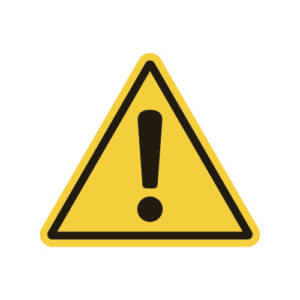
One more big tip before we jump in.
There’s one piece of advice that I think is incredibly important that you know before we begin.
In fact, I want you to write this down, then repeat it back to yourself over and over until it sticks.
Are you ready?
Here goes…
You cannot create a product branding strategy after your product launches.
If you try, your product will fail.
This is probably one of the biggest mistakes I see sellers make all the time. They find an exciting product using the Chrome Extension and Web App, they source it, order it, and launch it and only then do they consider what their brand is.
Of course, then their product completely collapses under the weight of better brands, those that did consider product branding when researching and sourcing their product.
And just one more thing (seriously this time).
Keep in mind that a lot of the elements in this series are a bit more advanced. If you are unsure of your ability to perform some of these tasks (or you simply don’t have the time), consider hiring a professional marketing freelancer.
We actually have a beta testing for freelancers who are certified Amazon specialists. You can learn more about our Jungle Market by clicking the button below.
. . .

How to create a product branding strategy.
A good product branding strategy has three main components each with their own important task within, many of which coincide with the 4-easy steps to creating a profitable Amazon product.
Those three main components are:
- Market research.
- Brand positioning.
- Product design.

Part 1. Market research for Amazon products.
Obviously, you know the importance of product research and looking for the 8 important features of a successful Amazon product. Focusing on the cold, logical metrics will help you remove any potential duds right off the bat. Since we spent six weeks covering product research and its importance, I’ll spare you the details on that.
But having a product that has seemingly high demand and low competition isn’t always enough. You’ve also got to create a product that’s going to stick out from every other product that’s out there. You need to know who your competitors are going to be, both big and small, and what they’re doing to capture market segments.
And more importantly, you’re going to want to find out what they’re not doing to capture other market segments. That’s where your product will shine.
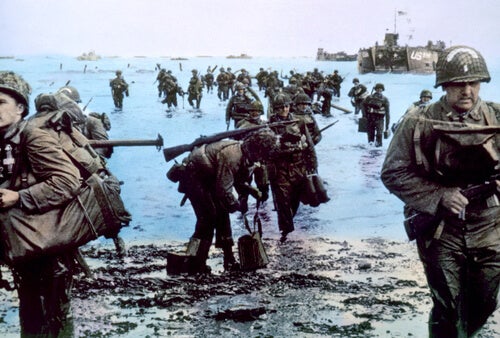
Geoffrey Moore’s Philosophy on Product Marketing Strategies
A book that you’ll often see me mention in blog posts is Geoffrey Moore’s awesome Crossing The Chasm. In it, he relates product launches and marketing strategies to the Allied invasion of Normandy June 6, 1944.
Here’s a quote that I love:
Our long-term goal is to enter and take control of a mainstream market (Western Europe) that is currently dominated by an entrenched competitor (the Axis).
For our product to wrest the mainstream market from this competitor, we must assemble an invasion force comprising other products and companies (the Allies).
By way of entry into this market, our immediate goal is to transition from an early market base (England) to a strategic market segment in the mainstream (the beaches of Normandy).
Separating us from our goal is the chasm (the English Channel).
We are going to cross that chasm as fast as we can with an invasion force focused directly and exclusively on the point of attack (D-Day).
Once we force the competitor out of our targeted niche markets (secure the beachhead), then we will move out to take over adjacent market segments (districts of France) on the way toward overall market domination (the liberation of Western Europe).
Translation? That’s your market research strategy!
How to do market research for your Amazon product.
Using the ideas above, we can break down what’s needed for market research as follows:
- Plot out your broad mainstream market.
- Identify the mainstream market’s biggest competitor.
- List the other smaller competitors in that market that are the same size as you.
- Determine your starting market base.
- Pick your niche market/starting point.
- Outline your adjacent markets.
- Create your overarching goal.
. . .
![]()
Step #1 – Plot out your broad mainstream market.
So you’ve got your totally awesome 1,000 unit per month product idea that you’re ready to tackle. Competition isn’t too heavy, either (of course, that could change in a very short period of time). But now it’s time to look at the bigger picture. What is the broad market that your product is in?
For example, if your product is a chef’s knife, then maybe your mainstream market is chef’s knives. Or going even more mainstream than that, perhaps it’s kitchen tools, or just kitchen and dining in general. How big can you possibly get?
Marketing Hack #1 – How big is your market?
One way you can find out how big your market is is by using a Google keyword search tool.
Personally, I prefer KWFinder by Mangools.
Simply type in what your product’s chief search term is and see how many monthly searches there are.
For example, for “chef’s knife” KWFinder says that there’s about 14,789 searches per month. But just under that, we can see that there’s 27,050 for “kitchen knife.” And cutlery gets even more hits with “74,045” searches.
Keep in mind that these aren’t categories you’re going to immediately break into, but at least it gives you an idea of how big of a goal you can set for yourself.
Imagine ranking for a keyword that got 74,045 searches per month! That could result in tens if not hundreds of thousands in monthly sales!
. . .

Step #2 – How to identify your biggest competitor.
Next, you’ll want to know who your biggest competitor is. This is going to be the big dog, the brand name, the mightiest tree in your Amazon selling forest. They may not even be the top company selling on Amazon, either, just the one that everyone knows about.
Going back to the chef’s knife example, that big brand could be Global, Wustof, or even Kitchenaid. These are the big names that people instantly recognize. But don’t worry… your job isn’t to topple these guys. Not yet at least. However, you can learn a lot from these as you’ll learn later on.
Marketing Hack #2 – Who’s your biggest competitor?
You’ve seen how big the market is using key word research tools, but now it’s time to see who’s the one that’s winning those big markets. And the easiest way to do that is simply through using the search engine page results (or SERP).
On Google, it will be those listings that appear at the top of the page, especially if it’s tossing out prices.
On Amazon, it’ll be the ones near the top of the rankings once you do a search. Using the Jungle Scout Chrome Extension, you can also get a glimpse at how many sales those products are making per month.
. . .
Step #3 – How to identify your same-level competitors.
It’s not enough to know who the big guys are. You’ve also got to know who you’re going to be going up against the moment you “hit the beach” so to speak. Many of these competitors will be fairly easy to get around as they’ll simply be copying (or trying to copy) what the big guys do. But there will be a few who’ve gone the extra mile and created products that stand out. While these competitors aren’t as big as the big ones, these are the ones that are the most dangerous since they’re still “fighting in the trenches.” They will still actively use PPC and promotional strategies and should be just as aware of your product’s presence in the Amazon market.
These competitors will have some of the following traits:
- In the Jungle Scout Chrome Extension, these products are often listed as “FBA.”
- They’ve only sold the product for a short time on Amazon. You can see how long a product has been selling on Amazon by scrolling on the product sales page to product description and reading the “”Date first available on Amazon” entry. Under 1-2 years means the product is fairly new.
- These products will only have a handful of reviews, typically no more than 100.
Marketing Hack #3 – Tracking your competitors.
It’s not enough to know who your competitors are, but you’re going to want to learn as much as you can about them, too. Using the Jungle Scout Web App‘s product tracker, start keeping tabs on the big movers in your market place. Keep an eye on how well they sell throughout the year as well as reviews. Many of these companies will have hundreds, if not thousands, of product reviews that can give you a ton of information on their product’s weaknesses.
. . .

Step #4 – How to determine your starting market base.
Your starting market base is the launch point for your product; it’s where you are right now and all of the resources that you have at your disposal. This includes:
- Startup capital.
- Knowledge and know-how.
- Market research.
- Brand positioning.
- Product development.
To enter the market and wrest control from the big, mainstream companies, you’ll start with what you have and transition into a niche–selling a unique product to a segmented market with Amazon FBA.
. . .
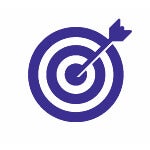
Step #5 – How to come up with a niche market for your product.
Now that you’ve got a look at the broader market and who you’re competing with you are ready to come up with your niche market. A niche market is a segmented portion of a larger market that may have limited or non-existant competition.
The process for finding a niche market is simple:
- Read your competitors’ reviews. Make sure you read the reviews for both your big and same-size competitors.
- Learn your competitors’ weaknesses. What are things that reviewers say over and over again about the products? What features are their products missing? How could those products improve?
- Discover your competitors’ customer segments. Who is buying your customers’ products? What other sorts of products are they buying (you can often learn this by clicking through the reviewer’s profile link).
- Look for what’s not there. Often, there is more said “between the lines” than there actually is in writing. For example, what features seem obvious but no one has mentioned. And what sorts of customers aren’t writing reviews–who are they, and why aren’t they buying the products?
- Review the current demand and competition for each potential niche. Using Amazon searches and the Jungle Scout tools again, look for demand in the marketplace for those ideas you came up with from your competitor’s flaws/missed opportunities.
- Select a niche. This is the hard part, but once you have plenty of data on what is and isn’t in the marketplace from the previous market research steps, you should have a clear winner.
Marketing Hack #4 – “This is great, but…”
“This is great, but I wish this came in brown,” says someone leaving a 3-star review on a product.
Often, you can learn a lot more from 3-star reviews than you can 1 or 5 stars.
A 3-star review is a reviewer’s way of saying, “This is great, but I wish it _______.” That blank is your future product.
Any time there is a problem with a product and no solution, that’s the market telling you, “Hey, make this thing for me!”
. . .
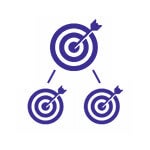
Step #6 – How to outline your adjacent markets.
After picking your primary niche, you’ll want to start planning ahead for the next big moves your brand will make. Remember, the goal is to eventually take a hold of the broader mainstream market. The best way to do that is one niche market at a time, just like in Moore’s World War II example. Start with the beaches, then move into the French districts.
Outline your adjacent markets by answering these questions:
- What is the next most logical product to complement your first product? Come up with 10-15 ideas.
- Where do these products rank on Amazon in terms of supply and demand? Use the Chrome Extension and Web App to help you figure this out.
- Will these adjacent markets help you get closer to the overall goal of defeating the larger competitors?
You won’t have to go into too much detail with these products yet, but it’s at least good to have a basic outline in place for future reference.
. . .

Step #7 – How to create your overarching goal.
Finally, it’s time you created your big goal statement. The best way to do this is with a template that riffs a little on the quote from Crossing the Chasm.
Our long-term goal is to enter and take control of [the mainstream market] that is currently dominated by [your biggest competitor].
For our product to wrest the mainstream market from this competitor, we must assemble an invasion force comprising of [your first product and others like it].
By way of entry into this market, our immediate goal is to transition from [where you are now] to a strategic market segment in the mainstream [your niche/segmented market].
Separating us from our goal is the chasm [any obstacles that stand in the way of launching your first product].
We are going to cross that chasm as fast as we can with an invasion force focused directly and exclusively on the point of attack (aka the niche) using Amazon FBA and the Genius Series marketing strategies.
Once we force the competitor out of our targeted niche markets, then we will move out to take over adjacent market segments which are on the way toward overall market domination.
Who knew that selling products could be like going to war? 😉
Having a clear goal proclamation like the one above, you will begin to see a clearer path to the next two steps of your product branding strategy.

Part 2. Brand positioning for Amazon products.
Now that you’ve gotten market research done and know who you and your product will be going up against, it’s time to focus on the next part of your product branding strategy: positioning.
What is brand positioning?
Brand positioning is the process of creating a unique impression in the mind of your customer so that they are able to associate a specific and desirable quality with your product. This helps make your product distinctive in the market place.
There is no one trick to positioning. There are countless ways to distinguish yourself from competitors. However, those distinctions, at the very least, should be:
- Logical and relevant. You can’t just throw in some random feature or design and hope that it works (although, arguably, companies like Old Spice, Squatty Potty, and Starburst used very off-the-wall and unusual advertising to draw attention to themselves for great effect).
- Unique. You can’t just copy what everyone else is doing. If you’re selling a garlic press, simply bragging that it crushes garlic without a mess probably isn’t enough–all of your competitors are probably boasting the same thing. But what if your garlic press was the only one with a gold plated handle? Oo la la!
- Difficult to copy. While this one is probably more of a “like to have”, creating a feature and position that’s difficult to copy can definitely help when it comes to figuring out your product’s unfair advantage (see below).
The best way to start this process is with a brand positioning statement.
What is a brand positioning statement?
Taking another page out of Geoffrey Moore’s Crossing The Chasm, the brand positioning statement is a template which helps you understand exactly how your product relates to the market.
The brand positioning statement has the following attributes:
- Target customer. This is your customer segment.
- Market definition. This is the actual larger market that you will be competing in.
- Brand promise. This is the compelling benefit (which can be emotional or rational) for your customer segment that your brand will own relative to your competition. This is your solution and unique value proposition.
- Reason to believe. What is the most compelling argument that your brand can deliver on its promises? This is the unfair advantage.
The template reads like so:
For [target customers], [company name] is the [market definition] that delivers [brand promise] because only [company name] is [reason to believe].
So, for example:
For restaurant chefs, Sharp AF Knives is the knife manufacturer that delivers the sharpest knives in the world because only Sharp AF Knives is made up of actual top culinary professionals with a combined 200 years worth of experience in kitchens around the globe.
How to create the brand positioning statement.
Now that you know what the template should look like, you’ll need to flesh it out a little. After all, simply writing down your brand positioning statement won’t simply will it into existence. You’ve got to fully plan out a product that works not only with competition, but within the metrics you discovered during the product research phase.
One tool that can help you with developing your brand positioning statement is Ash Maurya’s Lean Canvas tool.
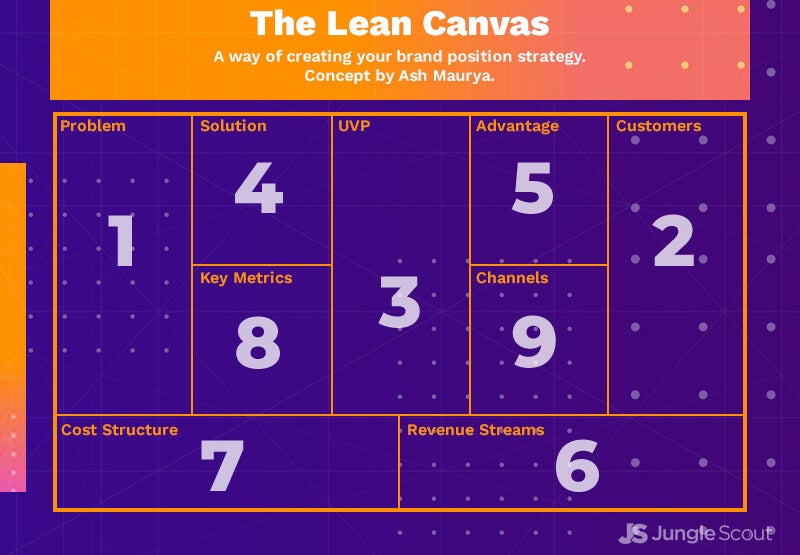
What is The Lean Canvas?
The Lean Canvas is a one-page product plan that helps product developers outline and strategize the most their lean startup products. In our last episode, I discussed The Lean Startup method and how the Build > Measure > Learn cycle can help you develop and improve on your products without spending a ton in resources. The Lean Canvas is a practical take on that philosophy. Additionally, it’ll help you come up with your brand positioning statement.
What are the elements of The Lean Canvas?
There are 9 parts of The Lean Canvas. They are:
- Problem.
- Customer Segments.
- Unique Value Proposition.
- Solution.
- Unfair Advantange.
- Revenue Streams.
- Cost Structure.
- Key Metrics.
- Channels.
Thanks to the product research phase and sourcing (which we’ll cover soon) you should be able to answer #7 and #8. Therefore, #6, for the time being, will simply be “Amazon sales” and #9 will also be Amazon and, hopefully, some of the marketing methods outlined later in this portion of the series.
But for the purposes of this episode on marketing and product branding, we’re going to focus on elements 1-5.
If you are able to successfully answer all 9 boxes on The Lean Canvas, then congratulations, you’re on your way to creating a successful Amazon product with a solid brand positioning statement.
. . .

Step #1 – How to determine your customer’s problem.
Coca-cola isn’t a drink, it’s a thirst-quencher. Nike isn’t a shoe, it’s a way of telling people that you “just do it.” And Jungle Scout isn’t a just a SaaS app, it’s a #freedombuilder.
Products aren’t things. They’re problem-solvers. Your customers have problems that they need to solve, whether they know it or not. And it’s your goal to figure out what those problems are. Find the problem and you’ll find the product.
Sometimes the problems are obvious. Maybe you’re tired of tracking mud through the house and need a good solution. Or perhaps you’re tired of not being able to use your iphone while you’re in the shower.
Other times, you can find the potential problem within another product. Perhaps you love your kitchen knife but wish you had a better way to store it. Or maybe you’re tired of buying all the components for your favorite game or sport separately and wish they came as a package.
Marketing Hack #1 – The infomercial test.
The best way to know if you’ve found a great problem, is to take your problem and phrase it as the leading hook for a make believe infomercial.
For example, “Are you tired of always tracking mud through the house?” or “Getting sick of buying all your sports gear separately?”
Create a list of these questions and cross reference those with the Chrome Extension or Web App to see if there’s a demand for products similar to the one you’re thinking of.
Later, this information will be important when you go to write copy, too.
. . .

Step #2 – How to create customer segments.
Whenever I start a blog post, I don’t just write out into the ether. I actually picture someone in mind that I’m writing for. Maybe it’s someone like my friend David who sells designer shades on Amazon. Or perhaps I’m writing to someone who’s a little more “top of funnel”, like my friend Heather who’s a working mom looking for a side hustle. Maybe it’s even someone who gave us negative feedback in the comments section. 😉 Whoever it is, I tailor the entire page to that person.
And that’s the next step to building your product branding strategy: creating customer segments through user experience (UX) personas.
What is a UX persona?
A UX persona is kind of like the imaginary prototypical person (or people) you predict will purchase your product. Knowing this information will help you create a real person with real problems that will help you pin-point your real solution (product).
Why do I need a UX persona?
- You know exactly who you are creating your product for. This will help you tie together your overall product branding strategy and craft a coherent message.
- Additionally, you will understand the basic problems, needs, and wants of your audience.
- This will help you create a more usable product.
- It reduces waste. You will not focus on features or marketing efforts that don’t help you
3 Methods of Creating a UX Persona
You will want to create 3-4 UX personas to help guide your product branding strategy. Try to make them varied, yet realistic as possible. Here’s a few tricks to coming up with good archetypes:
- Think of someone you know that would buy your product. This can be a friend, family, neighbor, or boss. This is a useful method, too, because later you can get feedback from the real life model.
- Observe buyers out in public. Okay, this one might make you a little Stalker-Stalkerson, but seeing people’s behaviors when they shop can help you learn a lot about who your target customer segment may be. Besides, if it worked for Paco Underhill, it can probably work for you, too.
- Look in a mirror. I promote picking passion products over “cold metrics” products mostly because the intuition I have towards products that I actually care about is far greater than just guessing or doing tons of research.
After you have your UX personas planned out, you’ll need to fill out a UX persona card. It’s kind of like creating a character in Dungeons & Dragons.
(Yeah, I’m a nerd…)
What questions do I need to ask my UX persona?
Just having a name and an idea isn’t enough to bring life to your imaginary buyer. You’ll also need some more details. This helps you really get to know who you’re selling to. Here’s a few questions you’ll need to ask your UX persona.
Start with the basics:
- What is your name?
- Are you male or female?
- How old are you?
- What is your job/career?
Then get a little more personal:
- What is your education?
- When you’re not working, what do you do?
- What is your biggest goal in life?
- How do you plan on achieving that goal?
- What is standing in the way of achieving that goal?
And don’t forget to ask a few more questions as it relates to your product.
- Are you already using this kind of product?
- How often would you use this kind of product?
- When would you use this kind of product?
- Where do you use this kind of product?
For fun, throw in a personal quote and a picture, too. This can be some random image from the internet or Shutterstock, or maybe even the person you know (or yourself).
Example of a UX persona:
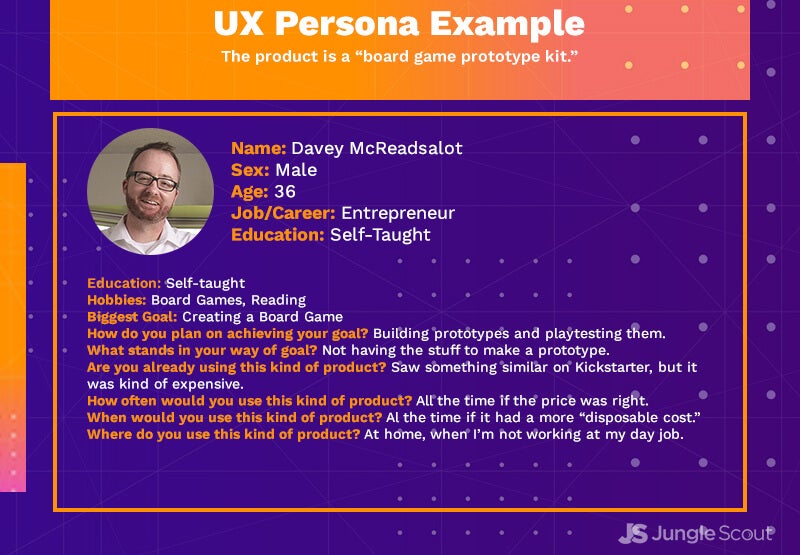
. . .
Step #3 – How to determine your product’s unique value proposition.
Coming up with a clear unique value proposition (UVP) is one of the most powerful product branding tactics you’ll have in your tool bucket. A UVP has three elements:
- The benefit that your product offers.
- How your product solves your customer’s needs.
- And what differentiates you from the competition.
The ability to answer this question will help shape the rest of your product branding strategy. Furthermore, it should be so solid that you’ll have no idea putting it on every piece of marketing material that you put out. For a lot of companies, it’s the first thing that you see at the top of their webpage. It’s also what you’ll see on their marketing campaigns.
And it doesn’t have to be complicated either. Sometimes you can sum it up with just a simple phrase.
Simple UVP examples:
- Jungle Scout’s UVP is “Amazon Product Research Made Easy”
- Microsoft’s Surface Pro boasts “Hassle-Free Connectivity”
- Wizards of the Coast’s front page headline states “We Make Games That Bring People Together”
- Starbucks gets pretty bold by proclaiming “The Best Coffee and Espresso Drinks”
- ClickFunnels also goes with the ‘easy’ angle, “Marketing Funnels Made Easy”
Many products, early in their life, state their UVP explicitly. But as the product grows and captures larger and larger shares of the market, the UVP becomes more well known and eventually implied; they become a house hold name.
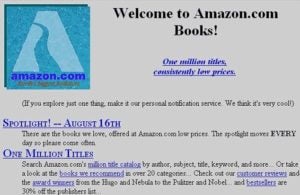
For example, Amazon had “one million titles, consistently low prices.” That UVP is now sort of an unspoken rule with Amazon (although they have far more than a million titles today).
Marketing Hack #2 – Your product’s subtitle.
Earlier, when you were trying to figure out the problem that your product fixes, I mentioned that you could use that statement as your “informercial hook.” Now that you’ve come up with your unique value proposition, you have the subtitle for your product. Just imagine the website that you’re going to create. It should read [your product] – [unique value proposition]. Kinda like “Jungle Scout – Product Research Made Easy.”
. . .

Step #4 – How to come up with the solution.
Before, we got a look at the problem that the eventual product was solving. Then, we determined our ideal customer with UX personas. After that, we came up with our UVP. Now it’s time to actually present the solution; this is when we pick the product.
If you’ve already sourced a product using the Jungle Scout Chrome Extension or Web App (probably a good idea to do this first), you may already know what this is. I won’t go too into depth on how to pick a product to sell on Amazon (you can go back to our third week in the Genius Series for that), but here’s the basics.
How to pick a product to sell on Amazon
- Look for products that solve a problem. Be sure to reference your UX personas and see if the product properly addresses each persona’s individual problems.
- Identify demand for the products. We covered the metrics you should look for in a past episode of the Genius Series.
- Determine how your product will be different than competitors. This is where the unique value proposition comes back into play. This will also help with the last area we’re going to focus on, your unfair advantage.
. . .

Step #5 – What’s your unfair advantage?
Here we are. We’ve got a product, people to sell it to in order to help them with their problems, and we’ve identified what makes our product better than our competitors’. Now it’s time to figure out the unfair advantage. This one’s a little trickier. However, with a little effort, there’s a few ways that can help you figure out what that is.
How to find your product’s unfair advantage.
- Read your competitor’s reviews. What are their products missing that you could easily add?
- Source your product for less. Often, it’s tough to get lower prices than competitors while sourcing, but sometimes you might have an edge that your competitors don’t.
- Create your own niche market. During the customer segment phase of The Lean Canvas, you may have identified an under served market that your competitors have yet to discover themselves.
- Read between the lines. Henry Ford once said, “If I kept giving customers what they wanted, I would have simply made faster horses.” In other words, sometimes you have to look not just for what is there, but also what’s not there.
- Use Peter Thiel’s 10x rule. Thiel wrote in Zero to One that if you want to have a product that can really disrupt the market, you’re going to need to create one that’s at least 10x better than anything that came before it.
- Find new marketing channels. Many Amazon sellers use the same, tired marketing channels to reach their customers. You can have an advantage of using new channels they haven’t previously tapped into.
- Create holistic products. Your product should have everything that your customer needs to start using it. “Batteries not included” is for the weak.
The other four elements of The Lean Canvas.
Because the other elements of The Lean Canvas pertain mostly to the product research phase, sourcing, and launch, we’ll leave those for other episodes of the Genius Series. But here’s the basics:
- Revenue streams. Your key revenue stream, starting off, will be Amazon sales. However, in this month of the Genius Series during the advanced marketing part, I’ll show you a couple more revenue streams you can create outside of Amazon such as Kickstarter and your own marketing funnel website.
- Cost structure. This is one you should start thinking about during the sourcing phase. But this will also cover spending money on ads, both Amazon PPC and ads outside of Amazon, as well as the other costs associated with buying products to sell on Amazon. I’ll go over some of those in later episodes.
- Key metrics. This is one that you should have focused on from the start during product research. Things such as average sales price, demand, average reviews, and profit margins are very important. Additionally, there’s a couple more important metrics such as LQS and opportunity score found in our research software which can help boost profits.
- Channels. Here’s another element that we’ll expand upon when we get to the more advanced portion of this month of the Genius Series. For now, the biggest ones you’ll need to know are Amazon PPC and deal sites.
Complete your brand position statement.
You’ve now got all the things you need to fill out your own brand position statement. You know who your customers are, who you are, what makes your product stand out from the rest, and the reason that your customers should believe it.
Armed with your brand positioning statement, lean canvas, and an overarching goal, it’s time to start developing your product.

Part 3. Amazon product design.
By now, you’ve written quite a bit about your product. And coming up with all of that information was probably exhausting. After all, you know who your competitors are, who your potential customers are, what sets you apart from the rest of the competition, and you have a clear goal for how you’re going to attack the market.
You can almost envision your product already, right?
Well, that was the purpose of those exercises. You need to know exactly the product that you plan on creating. In your mind, you should know how it works, how it feels, what the packaging and the logos should look like. You can even picture what your Facebook page might look, or how you’ll send out emails.
Now you understand, don’t you?
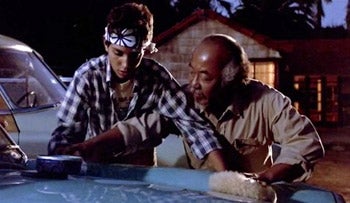
Wax on. Wax off. You’ve been training!
Now, it’s time to get that thing made.
How to design a product for Amazon.
Note: a lot of the steps in here will go over basic sourcing methods which we’ll go into greater detail later in the Genius Series. For now, just focus on product design.
Designing a product for Amazon can be simultaneously one of the most fun and must frustrating experiences in the entire private label process. But by having a clear objective thanks to the exercises from before, you’ll be able to overcome a lot of the challenges new sellers face while developing their product.
Here’s the basic steps:
- Create prototype designs.
- Contact manufacturers.
- Order and review samples.
- Design a logo for your brand.
- Develop the packaging for your product.
- Create a finalized prototype.
- Have amazing product photos taken.
- Build marketing assets for your product.
. . .

Step #1 – Create a prototype design.
Most of the time, you’re going to want to create a unique product, something that hasn’t existed on Amazon before. That doesn’t mean that it has to be something that’s never been invented before, like an anti-gravity water levitation device (if you think I’m joking, I actually saw one of these on Kickstarter recently). It can be something much simpler. You can change the color or size. Or you could pair it with products that complement it (maybe some that you discovered while plotting out your adjacent markets). Maybe it’s just something that already exists, but in a much nicer package.
But know this one caveat: the more you change and alter an existing design, the harder it is for future competitors to copy your product.
You don’t even have to be an amazing technical artist.
How to create prototype designs if you’re not a technical artist:
- Alter an existing image with Photoshop. Even if you have very rudimentary skills with Photoshop, you can create a prototype by altering an existing product photograph. There’s tons of courses on YouTube and Google that can show you how to make slight changes with the app.
- Hire a freelancer. There’s tons of professional freelancers out there that can create the images that you need and do it at a great value. We’ve actually do you a favor and put them all in one place with our brand new Jungle Market freelancer platform.
- Just do it by hand. Look, it doesn’t have to be perfect. It just has to be good enough so that when you send it to a manufacturer, they can understand what it is you’re trying to accomplish.
. . .

Step #2 – Contact manufacturers.
Now you have your design in place, either creating yourself or hiring someone to do it for you. It’s time to start hitting up some manufacturers. A lot of the methods we use to speak with manufacturers and communicate with them we cover in later portions of the Genius Series, but for now, here’s the basics:
How to contact manufacturers:
- Go on Alibaba to find manufacturers. If you don’t prefer Alibaba, you can also do a Google search for the specific type of manufacturer you’re looking for.
- Find 5-10 manufacturers that create products similar to yours.
- Contact each manufacturer with your designs.
- Ask lots of questions. We’ll cover the actual questions you should ask later in this series.
. . .
![]()
Step #3 – Order and review samples
Now that you’ve got a few manufacturers you’re working with, it’s time to start ordering samples and reviewing them. Again, we’ll go into greater detail on this part during the sourcing phase.
How to order samples:
- Order samples from 3-5 of the manufacturers you’ve spoken with.
- Time how long it takes to get the samples.
- When the samples arrive, review the quality of each sample.
- Compare the sample quality with your brand positioning notes. Does it match up with what you had in mind?
. . .

Step #4 – Design a logo for your brand
Now that you know who you’re going to be working with (or at least have it narrowed down to a few great candidates), you can start working on the product branding elements such as the logo and packaging.
The logo is one of the most important parts of your design. It needs to tie in with your product branding position.
I recommend creating at least 3-4 for logos and measuring it against the notes you have on your product. “Does this logo make sense? Does it convey the right message?” These are questions you should be asking while going through the logo creation process.
Furthermore, the logo is something that you definitely want to get right. So if you don’t have a strong graphic design background, hire a freelancer that does. Usually, freelancers who do logo design also specialize in packaging design since those go hand in hand.
You can find graphic designers on our freelance site Jungle Market who can create professional logos and packaging for you. Be sure to share your product branding notes with them, too.
. . .

Step #5 – Develop packaging for your product
Which restaurant would you rather eat at? One that has a clean, well-maintained landscape with possibly a valet or a maitre’d waiting for you to arrive? Or would you prefer one with litter in the untrimmed bushes whose head chef is standing outside wearing a dirty, sweat-stained apron while smoking a cigarette, barely giving you a notice as you shove past?
Of course, that’s all preferential. But which one do you think is going to ask for higher prices and actually get them?
First impressions are everything, therefore packaging is everything. It’s the super sturdy box that your iPhone came in. Or the red and white can you drank coke out of.
Why do you think Amazon puts their own tape on the box? Or the little smile on the side? Product branding, baby!
How to develop product packaging.
In addition to making a good first impression, your product packaging also has to convey information to the buyer, such as:
- What is the brand?
- What is the product?
- How do you use the product?
- Legal information, like where was the product made or does it have age requirements?
- The product’s identifier (UPC, GTIN, etc).
- How can we contact the brand owner?
Some of those things can be outside of the box and others can be in the box. Regardless, it’s all important information and needs to be included, especially for those of you who want to take your product to the next level with Amazon brand registry (of course, we’ll cover that later).
This is all pretty technical stuff, so again, if you need help, be sure to hire a professional freelancer in the Jungle Market who can help you with these things.
. . .

Step #6 – Finalize the prototype.
Almost at the finish line now. With your prototype, logo, and packaging designs, you can have your manufacturer create a finalized prototype. Do note, that if you’re making some drastic changes–such as needing a special mold made–there may be some pricey set-up fees. However, 9 times out of 10, those fees are refunded when you make the purchase.
But it’s important to see what your product–not just a sample of somebody else’s product–but what your product looks like before you create it. You’re going to want to have the full-on user experience. And ordering your finalized product prototype from the manufacturer is about as close as you’re going to get to it.
So make sure the prototype has all the things it needs to deliver including its original design, the final packaging, any accessories, and whatever else will be part of your customer’s experience.
. . .

Step #7 – Have amazing product photographs taken.
This step is tricky, since you may want to have product photos taken before you design the packaging so you can put your product’s image on the packaging. But if you’re going package sans product image, then make sure you have this done before you launch on Amazon.
Powerful product photos work as the sales people for your products. Not only do they encourage people to buy the product once they see it, but a good product photo can help you stand among the other SERP entries.
Frankly, this step deserves its own session, and fortunately, we’re going to do just that with our own Kym Ellis writing a break out episode for The Genius Series–we’ll call it episode 8.5, and we’ll have it posted soon. It will cover how to do product photograph all on your own.
And of course, if you don’t feel that you have the chops to create great product photos, product photography just happens to be another area that our freelancers cover with the Jungle Market.
. . .
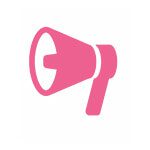
Step #8 – Build marketing assets for your product.
Finally, you’ll need to start building up marketing assets for your product that exist outside of the product itself. This is another key to an effective product branding strategy.
What are marketing assets?
Marketing assets are any graphic, piece of content, advertisement, or sales copy related to your product branding. These can include (but are not limited to):
- Facebook covers.
- Instagram images.
- Sales copy for your product’s listing.
- Banner ads for Google.
- Images for your site.
- Newsletter designs.
- Blog posts.
Of course, all of these elements involve skills in writing, copy writing, graphic design, SEO, social media, and more. All of this can be quite overwhelming. And of course, again, if these are things that you’re unable to accomplish on your own, we recommend that you hire a freelancer from the Jungle Market to help you out.
Why use a freelancer?
It’s far better to spend a little money on a freelancer than it is to do a half-assed job and put it out into the market.
Because while you might think that your marketing assets look like this…
In reality, it ends up looking more like this…
There’s no coming back from a bad looking product. The most you can hope for is to become an internet meme. But for the most part, you’ll end up with a bevy of bad reviews.
So try out the Jungle Market and see what we have to offer (click the button below).
Conclusion
We covered quite a bit of material in this episode, so we’re going to take a little break. But keep an eye out for the supplement to this episode when the Million Dollar Seller herself, Kym Ellis takes on the subject of product photography. And then, next week, the boss man, Greg Mercer, is going to cover the basics of the product launch phase of marketing, with Amazon PPC, promotions, and a top secret method that we haven’t yet discussed here (and I don’t think anyone else has either).
See you then!

 4 Comments
4 Comments
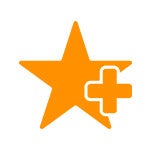


4 comments on “Market Research, Product Branding, and Product Development (Genius Series Episode 08)”